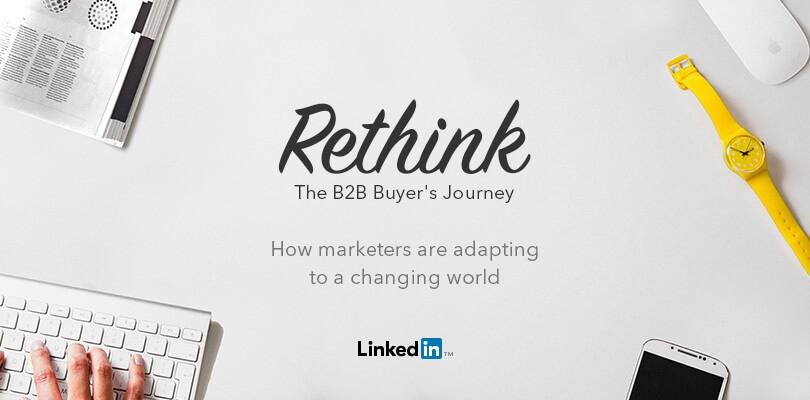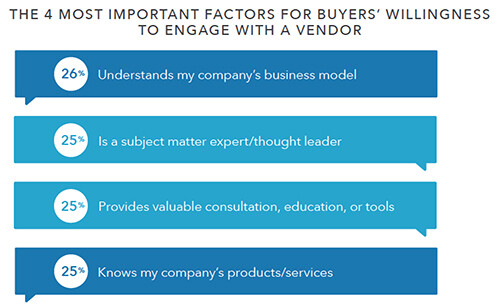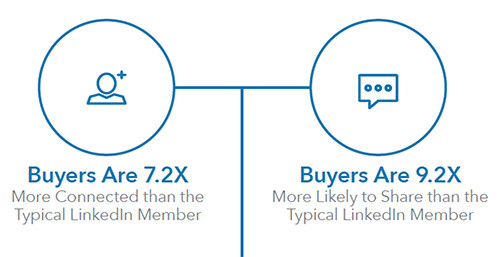Announcing the “Rethink the B2B Buyer’s Journey” eBook: 6 Takeaways for Marketers from New LinkedIn Research
The B2B buyer’s journey is in flux. With the search engines, social media, and mobile, B2B buyers have new ways to research their purchases, educate themselves on options in the market, and buy products and services. Forrester Research says as much as 90 percent of the buyer’s journey may be complete before a buyer reaches out to a salesperson.
In LinkedIn’s new ebook, “Rethink the B2B Buyer’s Journey,” we share our extensive global research on the ways buyers, marketers, and salespeople act and interact with each other have changed. For this research, LinkedIn surveyed more than 6,000 buyers, marketers, and salespeople in Australia, Canada, France, Germany, India, the United Kingdom, and the United States.
The research indicates that marketers must rethink many of the ways they communicate with their customers and how they align with their colleagues in sales. Here are six key takeaways for marketers from “Rethink the B2B Buyer’s Journey”:
1. Prioritize delivering authentic and helpful knowledge your prospects crave
LinkedIn research showed the thing that buyers most want from their vendors is knowledge. The top four most important factors influencing a buyer’s willingness to engage with a vendor all involved knowledge, as the chart below demonstrates:
2. Strive to reach the entire buying team, not just the key decision maker
Our research found that if your company is not known company-wide, then your company is not known. We found that from 3.1 to 4.6 additional departments – such as information technology or finance or human resources – influenced the buying decision, depending on the industry. This finding shows that the B2B buying process is a team game, and your brand must be familiar to the entire team, which suggests that branding and awareness advertising is essential for getting your sales team in the door.
3. Deliver a full range of content, from product demos to case studies to thought leadership
The research found that buyers need a variety of content to help them make their purchase decision. On one hand, they need basic product information and demos to understand the product, but they also require thought leadership and other helpful content to help buyers determine where the industry is headed. The implication for marketers is that they must have their message present throughout the full funnel, from awareness and thought leadership content in the upper funnel to data sheets and demos in the lower funnel. This is how to assemble a complete marketing program.
4. Leverage social media through the entire buying process
Buyers use social media at every stage of the funnel: awareness, scope, plan, select, implement. In fact, our research showed that buyers place social media in the top three content channels for each stage of the funnel. For example, 67 percent of buyers used social media for awareness, more than any other channel. Specifically, research also showed that B2B buyers tend to be more engaged on LinkedIn than other average users of the platform. For instance, buyers are 9.2 times more likely to share content and 7.2 times more connected than the typical LinkedIn member.
5. Marketing and sales should align on a broader definition of nurturing – beyond classic relationship building
Nurturing, which used to be the sole domain of the sales team, is increasingly the responsibility of marketing as the buyer’s journey has moved online. Effective marketers are moving their nurturing efforts beyond email nurturing to display and social advertising and other forms of multi-channel nurturing. With marketing more involved in the nurturing phase of the buyer’s journey, alignment between marketing and sales is more important than ever. Our research shows that the higher level of sophistication that salespeople have in multi-channel nurturing indicates greater alignment between the two teams. Specifically, 71 percent of salespeople who used multi-channel nurturing said their relationship with marketing was growing stronger, but only 47 percent of salespeople who didn’t use multi-channel nurturing said their relationship with marketing was growing stronger.
6. Deploy sales technology to drive better sales and marketing alignment
Sales process technology -- the most prominent example of which is customer relationship management software -- is still growing in adoption. CRM software and other technologies can offer an opportunity for sales and marketing to work together in implementing this kind of software. It’s a chance for sales and marketing to boost alignment. Our research shows that marketers and salespeople who report they are knowledgeable about sales technology have significantly stronger alignment. Specifically, 77 percent of marketers who are knowledgeable about sales technology report that their relationship with sales is growing stronger, while just 55 percent of marketers who are not knowledgeable about sales technology said their relationship with sales is growing stronger.
For a deeper dive into this research on how the buyer’s journey is being transformed – and how marketers can take advantage -- download “Rethink the B2B Buyer’s Journey” today!
Related articles






